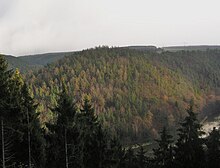Grossdraxdorf roof hill
The Großdraxdorf roof hill is an archaeological site near Großdraxdorf , a hamlet in the town of Berga / Elster in the Greiz district in Thuringia . In terms of the area, it is the largest soil monument in the northern Vogtland.
location
The area of the settlement and ramparts is on the Eselsberg , about three kilometers south of the municipality of Wünschendorf / Elster and the adjacent corridor of the town of Großdraxdorf to the south. The plateau with its wooded steep slopes rises up to 90 meters above the valley floor of the White Elster. On the western edge of the plateau, the Kirchsteig, coming from Großdaxdorf, leads to Veitsberg past the Weiberstein rock, known for several legends , and first strives towards the northern tip of the mountain spur. The Teufelskanzel located there is also a place known through legends. The sparse remains of an abandoned medieval spur castle, which was also used as the field name Burgstatt in older maps for the area adjacent to the south, were found in the wood at the edge of the demolition . For the striking remains of old Wallburg the name was roof hill selected.
Age and settlement phases
The first traces of human life come from the end of the Neolithic , it is pottery and tool remains .
The Bronze Age grave finds, some of which were found under the remains of a wall, represent the remains of a burial mound field. At the end of the Bronze Age, an extraordinarily high wood-earth-stone construction was built as a wall fortification. The age of growth of the tree trunks used for the ramparts is, according to radiocarbon dating, around 1260 to 980 BC.
The extensive ramparts were continuously populated with interruptions until the Middle Ages. The current field names Burgstatt and Wüstes Gut are reminiscent of the last settlement phase in the 13th century.
A presumed Slavic hill fort from the 8th to 10th centuries and the local German seat of power do not seem to have existed at this place.
In 1847, a significant part of the area was leveled in favor of agricultural use, in the remaining part visitors can see the remains of the former ramparts. As early as the beginning of the 19th century, peasants in the surrounding towns started digging in the ramparts in order to recover ash, cinder residue and charcoal, which they used to fertilize the fields and gardens. The randomly uncovered finds quickly aroused the interest of the Vogtland Antiquities Research Association, which carried out the first scientific investigations from 1854.
Found objects
The Museum Reichenfels-Hohenleuben shows finds from the first excavations in 1854/55.
overlap hatchet
Clay spindle whorl
Web links
Individual evidence
- ↑ a b c Karl Peschel: The Eselsberg near Großdraxdorf, City of Berga, district of Greiz, in prehistoric times - a contribution to the history of research in Thuringia . In: Old Thuringia . tape 39 . Beier & Beran, Weimar 2006, ISBN 978-3-937517-61-2 , pp. 5-68 . (as a digitized version at URMEL)
- ↑ a b c d The northern Vogtland around Greiz . A geographical inventory in the area of Greiz, Weida, Berga, Triebes, Hohenleuben, Elsterberg, Mylau and Netzschkau. In: Leibniz Institute for Regional Geography (Ed.): Landscapes in Germany . tape 68 . Böhlau Verlag, Leipzig 2006, ISBN 3-412-09003-4 , Großdaxdorf, to Berga since 1994, with Dachshügel and Dachsdorfer Bastei, p. 105-108 .
- ↑ Kurt Serwotke: Oak leaves booklet 7 Heimat- und Geschichtsverein, Berga / Elster 2013.
- ↑ contributions to the history O.Fischer publishing Aderhold, Weida / Th. 1930
- ^ City of Berga - Großdraxdorf ( Memento from June 3, 2009 in the Internet Archive )
- ^ Museum Reichenfels. Retrieved May 26, 2017 .
Coordinates: 50 ° 46 ′ 40.8 ″ N , 12 ° 6 ′ 31.7 ″ E








